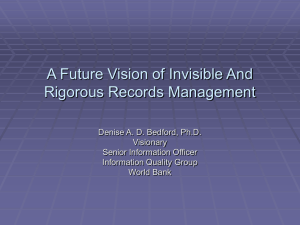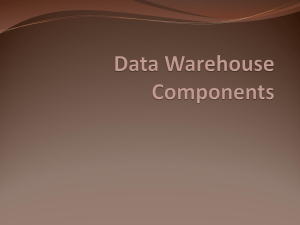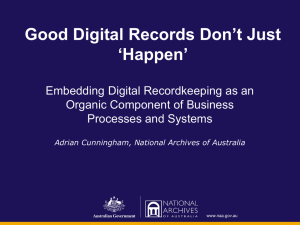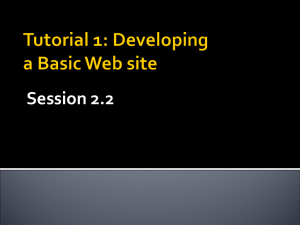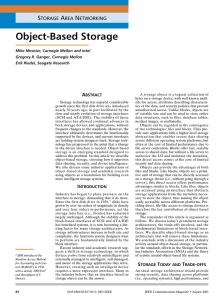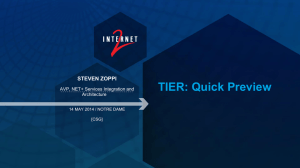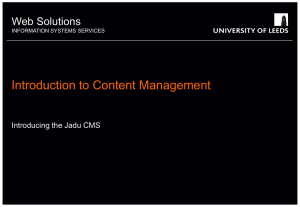Object-based Storage
advertisement
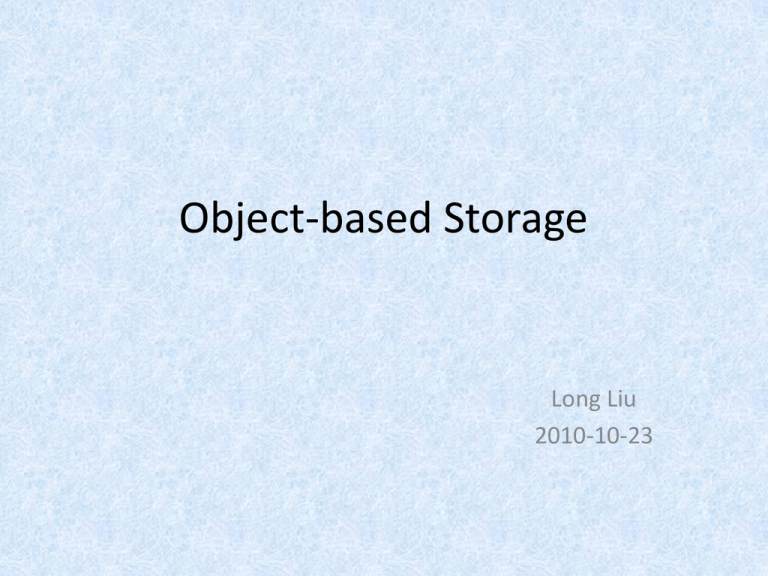
Object-based Storage Long Liu 2010-10-23 Outline • • • • • Why do we need object based storage? What is object based storage? How to take advantage of it? What's the status of object based storage? What can we do about it? Outline • • • • • Why do we need object based storage? What is object based storage? How to take advantage of it? What's the status of object based storage? What can we do about it? Background • Existing enterprise storage infrastructures are feeling the strain • the volume of data generated by many network-based applications continues to escalate Background Two Technologies: • Files: – Flexible data sharing – Secure • Blocks: – High performance – Scalable Files Blocks Comparison Objects can be regarded as the convergence of two technologies: files and blocks Operations: Operations: Create object Delete object Read object Write object Read block Write block Addressing: Addressing: Block range [object, byte range] Block Based Disk Object Based Disk Comparison Traditional Storage Applications Object-based Storage Applications File System File System Object Interface Logical Block Interface Hard Drive Storage component Object-based Storage Device (OSD) Comparison Two changes : Object-based storage offloads the storage component to the storage device The device interface changes from blocks to objects (a) Traditional model CPU Applications System Call Interface File System User Component File System Storage Component (b) Object storage model CPU Applications System Call Interface File System User Component Object Interface Block Interface Block I/O Manager File System Storage Component Block I/O Manager Storage Device Storage Device Motivation • Improved device and data sharing – Platform-dependent metadata moved to device • Improved scalability & security – Devices directly handle client requests – Object security • Improved performance – Data types can be differentiated at the device • Improved storage management – Self-managed, policy-driven storage – Storage devices become more autonomous Objects Outline • • • • • Why do we need object based storage? What is object based storage? How to take advantage of it? What's the status of object based storage? What can we do about it? Object-based Storage Object OSD(Object-based Storage Device) MDS(Metadata Server) Object-based Storage Object OSD(Object-based Storage Device) MDS(Metadata Server) Object •An object is a logical unit of storage — ID (Identification) — Application data — Metadata which includes block allocation and length — Attributes that is accessible by users •Objects have file-like methods — open, close, read, write Object •The root object -- The OSD itself •User object -- Created by SCSI commands from the application or client •Collection object -- A group of user objects, such as all .mp3 •Partition object -- Containers that share common security and space management characteristics Object P4 P3 P2 OSD P1 Root Object (one per device) U1 User Data Attributes Partition Objects Collection Objects Metadata User Objects (for user data) Object ID Object-based Storage Object OSD(Object-based Storage Device) MDS(Metadata Server) Object Storage Devices Intelligence with its own CPU, Memory, Disk, Network Redistribution with specific strategy Objects’ metadata management Object Storage Devices Two changes : Object-based storage offloads the storage component to the storage device The device interface changes from blocks to objects (a) Traditional model (b) Object storage model CPU CPU Applications System Call Interface File System User Component File System Storage Component Applications System Call Interface File System User Component Object Interface Interface Block I/O Manager File System Storage Component Block I/O Manager Storage Device Storage Device Object Storage Devices Expect wide variety of Object Storage Devices Disk array subsystem 2 SATA disks – 240/500 GB Highly integrated, single disk 4 Gbps per shelf to cluster Orchestrates system activity Balances objects across OSDs Stores up to 5 TBs per shelf Object-based Storage Object OSD(Object-based Storage Device) MDS(Metadata Server) Metadata Server Control the interaction between clients and OSDs Dataflow of Metadata Client Applications File Client System Metadata Manager Storage component Metadata Servers (MDS) Object Storage Devices (OSDs) Object-based Storage Device (OSD) Outline • • • • • Why do we need object based storage? What is object based storage? How to take advantage of it? What's the status of object based storage? What can we do about it? Interface T10 OSD Commands(face) GET/SET ATTR READ/WRITE OSD Target CREATE/REMOVE OSD Client 10001110101 10000001110 11001110111 10001111000 ..… OSD Interface Opaque attributes (stored only) Shared attributes (stored & processed) User Data Object Attribute pages OSD Commands(Interface) • Basic Protocol – READ very basic – WRITE – CREATE space mgmt – REMOVE – GET ATTR attributes – SET ATTR • opaque • internal • shared • Specialized – APPEND – CREATE & WRITE – FLUSH – LIST • Security – Authorization – Integrity – SET KEY – SET MASTER KEY shared secrets • Groups – CREATE COLLECTION – REMOVE COLLECTION – LIST COLLECTION • Management – CREATE PARTITION – REMOVE PARTITION – FLUSH PARTITION – PERFORM SCSI COMMAND – PERFORM TASK MGMT Storage Technology Today 1 2 3 4 • Direct attached storage (DAS) • Fabric Attached Storage (FAS) -Network Attached Storage (NAS) -Storage Area Networks (SAN) Direct Attached Storage LAN Windows UNIX Windows RAID BACKUP SERVER RAID RAID RAID TAPE A traditional Direct Attached Storage model Fabric Attached Storage C/S Fabric Attached Storage SERVER CLIENTS DATA Network Attached Storage This figure illustrates NAS being used to share files among a number of clients. Clients File I/O IP network Storage area network Block I/O File server Block storage The files themselves may be stored on a fast SAN Storage Area Networks Clients This figure illustrates a SAN file system Data The files themselves are stored on a fast storage Area to which the clients are also attached. Servers Storage area network Block-based storage devices Security CLIENTS METADATA SERVERS Capability Attribute NETWORK Capability Attribute OBJECT-BASED STORAGE DEVICE Outline • • • • • Why do we need object based storage? What is object based storage? How to take advantage of it? What's the status of object based storage? What can we do about it? Status • Industrial – Lustre – Panasas • Academic Status • Industrial – Lustre – Panasas • Academic Lustre • First open sourced system with object storage • High-performance parallel file system • Consist of clients, MDS and OST(Object Storage Targets) Lustre METADATA SERVER CLUSTER NETWORK CLIENTS Data Management OBJECT STORAGE TARGETS(OST) Panasas • High-performance file system • Consist of OSD, Panasas File System, MDS Panasas Key Object Storage Features Intelligent space management in storage layer ßMedia geometry aware placement ßData aware prefetching, caching & recovery Encapsulation of data and attributes ßNative object interface, good programming model ßStorage interpreted attributes for per file properties Key Object Storage Advantages ßRobust, shared access by many clients ßScalable performance via an offloaded data path ßStrong fine-grained end-to-end security Panasas • Clients are from Energy, Government, Finance, Manufacturing and Higher Education Status • Industrial – Lustre – Panasas • Academic A Design of Metadata Server Cluster In Large Distributed Object-based Storage Motivation: • Metadata server cluster maybe the bottleneck • Frequent metadata access and movement • Terrible load balance management A Design of Metadata Server Cluster In Large Distributed Object-based Storage Application Server Cluster VoD Server Web Server Database Server E-mail Server File Server Metadata Data Storage Network (Fibre Channel) MDS Cluster Security Object-based Storage Device Cluster Object-based Storage System Architecture A Design of Metadata Server Cluster In Large Distributed Object-based Storage Application Servers Hashing Partition Application File Hashing Manager Mapping Manager Metadata Server Cluster Logical Partition Manager Metadata Server Backend Common Storage Space Figure 3. Hashing Partition Hashing Partition: A total solution for –File hashing –Metadata partitioning –Metadata storage A Design of Metadata Server Cluster In Large Distributed Object-based Storage Pathname: /Dir1/Dir2/filename 1 ①.Filename hashing ②.Selecting MDS through Mapping Manager ③ .Accessing metadata by pathname hashing result ④.Returning metadata to application server 4 Pathname Hashing Result (i) Mapping Manager Pathname Metadata & etc Pathname Hashing Result (i+1) 2 Metadata Server Cluster 3 Pathname Metadata & etc Logical Partitions Figure 4. Metadata Access Pattern A Design of Metadata Server Cluster In Large Distributed Object-based Storage Hashing Partition Mapping Manager 2 1 Metadata Server Cluster 3 Logical Partitions 4 Common Storage Space Figure 5. MDS cluster failover procedure Outline • • • • • Why do we need object based storage? What is object based storage? How to take advantage of it? What's the status of object based storage? What can we do about it? From Our Perspective The End Thank you

